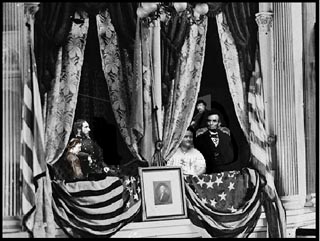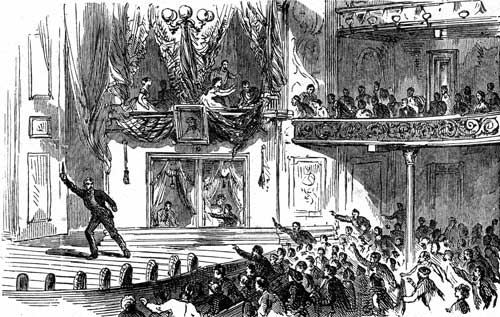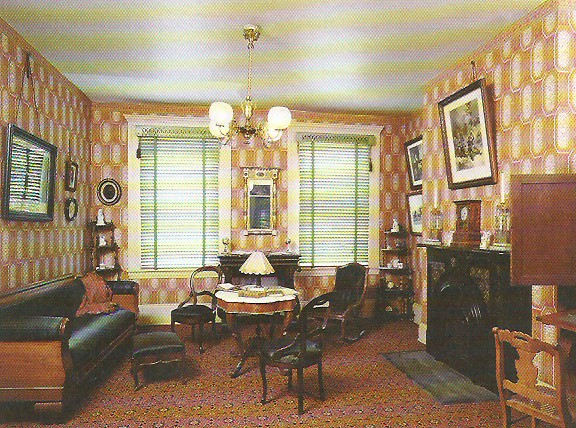MARY TODD LINCOLN'S ULTIMATE AGONY
|
|
On the evening of April 14, 1865, President Abraham Lincoln and his wife, Mary, were enjoying the British comedy Our American Cousin at Ford's Theatre. (To the right is an image of a facsimile of a playbill.) They were sitting in an upper right-hand box. Mary wore a black and white striped silk dress, with black lace veiling on her hair. A young couple, Major Henry Rathbone and Miss Clara Harris, shared the box with the Lincolns. As the play progressed, Mary sat very close to her husband, her hand in his. She whispered to him, "What will Miss Harris think of my hanging on to you so?" The president replied, "She won't think anything about it."
Those are the last recorded words of Abraham Lincoln. It was between 10:15 P.M. and 10:30 P.M. On stage actor Harry Hawk was saying, "Don't know the manners of good society, eh? Well, I guess I know enough to turn you inside out, old gal - you sockdologizing old mantrap!" John Wilkes Booth opened the door behind where the president was sitting and shot him in the head at near point blank range. Mary, still holding the president's hand, clutched her husband. His head inclined toward his chest. Booth then stabbed Rathbone and jumped over 11 feet to the stage. Mary screamed as Rathbone yelled, "Stop that man!" But Booth was able to escape from the theater.
|
|
|
|
Charles Leale, 23, was the first doctor to reach the State Box. He lifted Mary's head off the president's chest. Mary said, "Oh, Doctor! Is he dead? Can he recover? Will you take charge of him? Oh, my dear husband! My dear husband!" Mary was now in a state of near collapse. She sat down on a couch adjacent to the chair in which she had been sitting. Leale asked a few soldiers to place the president on the floor. Other doctors arrived in the box. With the help of some brandy and water, the doctors were able to bring the stricken man to a state of irregular breathing and feeble action of the heart. After examining the nature of the wound, Leale said, "His wound is mortal. It is impossible for him to recover." |
|
|
 |
The doctors decided Lincoln should be taken to the nearest house. With the help of several soldiers, the president was carried out of Ford's Theatre. Rathbone, leaving a trail of blood from his knife wound, and Mary followed behind. She was crying and wringing her hands. From the Petersen House, 25 year-old Henry S. Safford shouted, "Bring him in here!" The president was carried up the steps of the Petersen House (the building in the center of the photograph). Mary momentarily lost sight of the president and yelled out, "Where is my husband? Where is my husband? Why didn't he kill me? Why was I not the one?" The president was carried into a room rented by William T. Clark. Being so tall, the president had to be placed diagonally on Clark's bed. Mary stood in the doorway along with Laura Keene (female lead of Our American Cousin) and Clara Harris. Mary entered and bent over her husband's unconscious face covering him with kisses, calling him by endearing names, and begging him to speak. As the doctors began their examination of the president, Mary was asked to wait in the front room of the Petersen House. The deathwatch began.
Mary kept a nightlong vigil, alternately crying and making forays from the front parlor to the room where the president lay. She would kiss him and call him by tender names. Once she asked that son, Tad, be sent for; Tad had been watching a play at Grover's Theatre when his father was shot, but he was then taken to the White House, not the Petersen House. The Lincolns' older son, Robert, was at the White House at the time of the shooting and immediately went to be with his mother at the Petersen House when he heard the tragic news. He spent the night weeping and trying to comfort his mother.
|
|
|
THE FRONT PARLOR OF THE PETERSEN HOUSE WHERE MARY AWAITED WORD ABOUT HER HUSBAND |
Around 6:00 A.M. it began to rain heavily. The dawn was very gray. Mary made her last visit at approximately 7:00 A.M. By now her husband's features had become distorted. His right eye had become very swollen and discolored. He was breathing at long pauses - a sign of imminent death. Mary said, "Love, live but one moment to speak to me once - to speak to our children." Then she let out with a piercing cry and fell half-fainting to the floor. Upon hearing this, Secretary of War Edwin Stanton said, "Take that woman out and do not let her in again." Mary was assisted back to the front parlor. She was heard to say, "Oh, my God, and I have given my husband to die."
Shortly thereafter, at 7:22 A.M., the 16th president of the United States passed away. Mary was not in the room at the moment of death. Nearly two hours passed before she was in any condition to be taken back to the White House. Slowly, she was led outside to a waiting carriage. Looking across the street to Ford's Theatre, she cried out several times, "That dreadful house - that dreadful house! This awful place!"
During the autopsy of her husband (which took place in the guestroom in the northwest corner of the second floor of the White House), Mary sent a messenger to request a lock of hair, and Dr. Robert K. Stone clipped a lock for her. Mary remained mostly bedridden in the White House for the next 5 weeks. She did not attend any of the martyred president's funerals, either in Washington, along the route of the funeral train, or the final one on May 4th in Springfield. Finally, on May 22nd, wearing black, Mary walked down the White House stairs for the last time. She was accompanied by her two sons, Elizabeth Keckley (her seamstress and good friend), and Dr. Anson G. Henry, an intimate friend of the Lincoln family. The group boarded a train destined for Chicago where Mary would live for the next several years. Her bereavement was still overwhelming. She would never be the same again. |
|
Note: Tad Lincoln went to Grover's Theatre that evening accompanied by Alphonso Donn, one of the group of Metropolitan Washington police officers assigned to the White House. He was viewing the play Aladdin! or His Wonderful Lamp when the information about the president's shooting was whispered in Donn's ear. After Tad had departed, theater manager C. D. Hess stepped onto the stage and announced the tragedy to the audience. Tad was taken to the White House where a White House doorman, Tom Pendel, tried to calm his fears and put him to bed at about midnight.
Over the years there have been several misconceptions about the Petersen House and the Petersen family itself. Robert T. Bain, great, great, great grandson of William Petersen, has tried to set the record straight in his 2005 publication entitled Lincoln's Last Battleground: A Tragic Night Recalled. Click Here if you are interested in obtaining a copy of Robert Bain's book.
The photograph of the front parlor of the Petersen House came from p. 21 of The Assassination of Abraham Lincoln by Brendan January (New York, Children's Press, 1998).
Thank you to Curtis Pringle for sending me his poem entitled Grace Be With You Mrs. Lincoln:
|
Grace be with you Mrs. Lincoln
With blood on your hands in heartfelt yearning to see another day.
Another moment that he would again gaze in your eyes with smiling countenance.
Grace be with you Mrs. Lincoln
For you simply wanted to love a bit more longer
That the blast of the moment changed your desiring dreams for ever in a day.
Grace be with you Mrs. Lincoln
Death’s stage upstaged his dear soul with only a few breaths longer
You reached out to touch his Colden brow to wish upon what would be no more.
Grace be with you Mrs. Lincoln
The smile vanished in that darkened night
You grasped to see the calming sigh of him again and again.
Grace be with you Mrs. Lincoln
Many did mourn this dear one.
But never as you did in your dreamless slumber of eternity
|
|
|
The sketches of the Lincoln party in the State Box (with Booth in the background) and of the stricken president are the work of James Warner. James Warner lives in Cadillac, Michigan and enjoys illustrating, woodcarving and antique collecting. To contact Mr. Warner for artwork please call (231) 577-4207 or send e-mails to: jameltrib@yahoo.com. Please type "Lincoln" in the subject line of your e-mail. Mr. Warner always enjoys hearing from people. However, all mail without the name "Lincoln" in the subject line will NOT be answered. Sorry for the inconvenience. ARTWORK NOT TO BE REPRODUCED FOR USE ON ANY OTHER SITE WITHOUT PERMISSION! |
|
Sources used: Mary Todd Lincoln: Her Life and Letters by Justin G. Turner and Linda Levitt Turner, Twenty Days by Dorothy Meserve Kunhardt and Philip B. Kunhardt, Jr., A. Lincoln: His Last 24 Hours by W. Emerson Reck, Mary Lincoln: Biography of a Marriage by Ruth Painter Randall, The President's Wife: Mary Todd Lincoln by Ishbel Ross, Mary Todd Lincoln: A Biography by Jean H. Baker, The Day Lincoln Was Shot by Jim Bishop, and The Farewell to Lincoln by Victor Searcher. |
|






